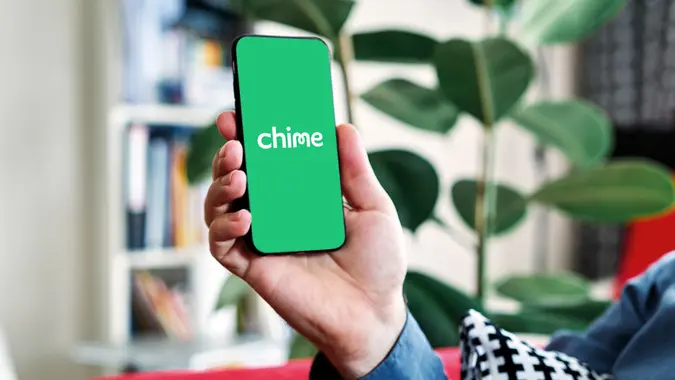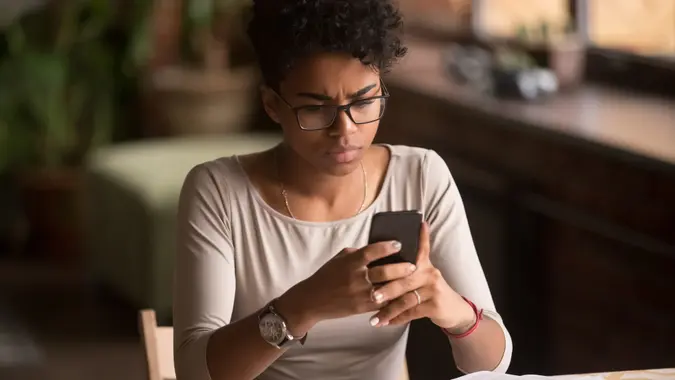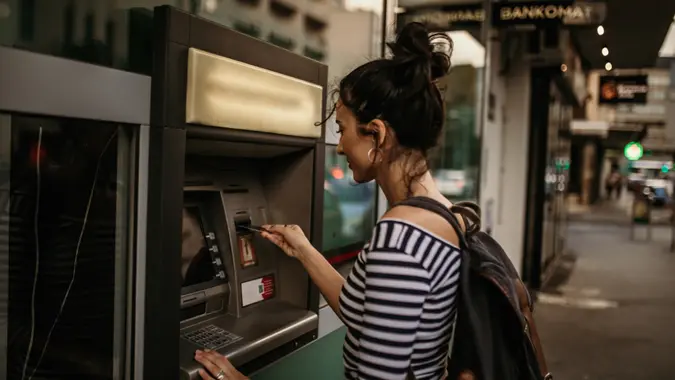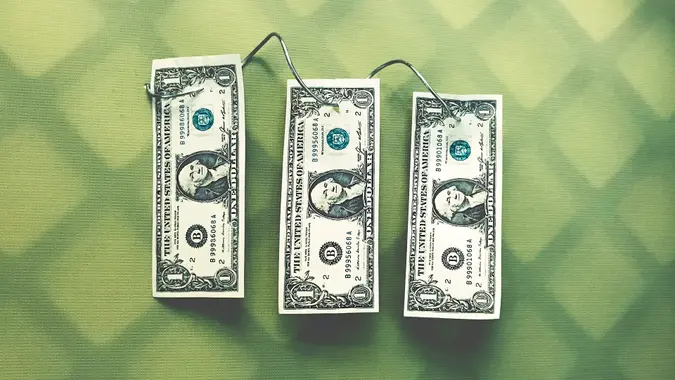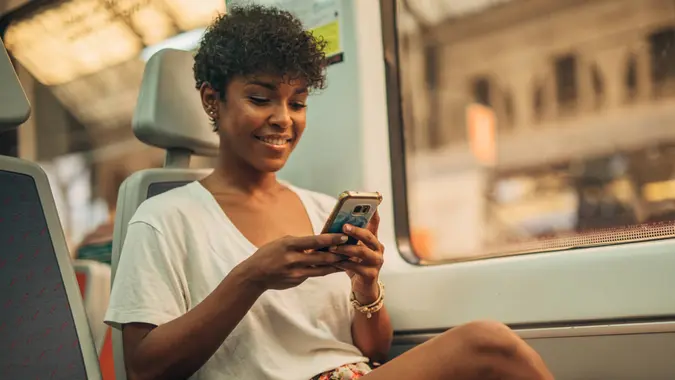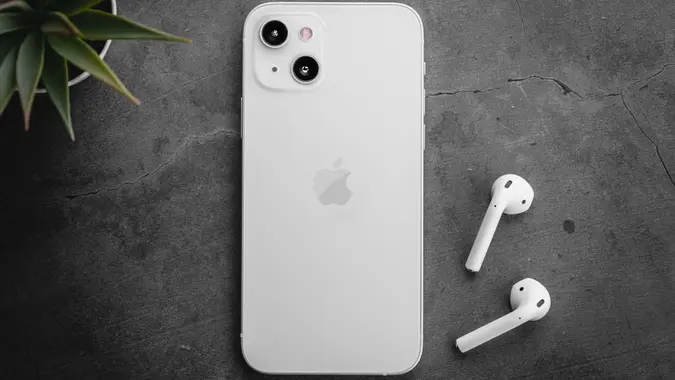Is Apple Pay Safe? What You Need To Know

Commitment to Our Readers
GOBankingRates' editorial team is committed to bringing you unbiased reviews and information. We use data-driven methodologies to evaluate financial products and services - our reviews and ratings are not influenced by advertisers. You can read more about our editorial guidelines and our products and services review methodology.

20 Years
Helping You Live Richer

Reviewed
by Experts

Trusted by
Millions of Readers
Storing credit and debit cards in a digital wallet keeps you connected to your money, and Apple Pay is one of the most popular mobile payment apps. But is Apple Pay safe? Yes, thanks to multiple layers of security features. Learn how Apple Pay works to protect your financial information.
How Does Apple Pay Work?
Apple Pay works by storing your card details, so you can make contactless payments in person, online and in iOS apps. You don’t need a physical card to pay — just your Apple device.
Apple Pay Basics
Apple Pay is a virtual wallet used for mobile payments. It’s compatible with:
- iPhones: Via NFC technology for tap-to-pay transactions
- Apple Watch: Linked to your iPhone for wrist payments
- Mac and iPad: For online and in-app purchases
Apple Pay is built into your device. You don’t need to download a separate app to use it. You can add debit and credit cards to your digital wallet by tapping them or scanning them, and verifying your info with your bank if necessary. The number of cards you can add depends on your device and the version of iOS it runs.
You can use Apple Pay online, in apps and at most retailers that accept contactless payments. It’s quick, convenient and most importantly, secure.
Key Features of Apple Pay
How is Apple Pay safe? It starts with something called tokenization.
When you add a credit or debit card to Apple Pay, a Device Account Number is assigned to your device. This acts as kind of a token, which replaces your card number.
Each card you add to Apple Pay gets a unique token. When you make a payment, Apple Card transmits your card’s token — not the number — to the merchant. Your account is kept secure, as the data is encrypted and requires biometric identification.
Here’s an example. Say you’re buying groceries and want to pay at checkout with your iPhone. You would:
- Double-click the side button and authenticate with Face ID or enter your passcode.
- Select your default card, or tap a different card to authenticate it for payment.
- Hold the top of your iPhone near the contactless payment reader until it says “Done” and displays a checkmark.
You don’t need to insert a card or enter a PIN. Everything happens through your device.
If you’re paying with Apple Watch, you’ll double-click the side button, which opens your digital wallet to your default card.
To pay online or in apps, you’ll select Apple Pay at checkout and verify with Face ID, fingerprint ID or your passcode, depending on which device you use.
Either way you pay, Apple Pay encrypts the transaction data before sending it to the merchant. Your card details are never stored and merchants never have access to your card information. Biometric login, meanwhile, ensure that no one but you is using your device to pay.
Why Is Apple Pay Safe?
Apple Pay is safe because of its multi-layered approach. Some key features have already been covered — like tokenization, encryption and biometrics — but here’s a deeper dive into how each protects your card details.
Tokenization and Encryption
Tokenization swaps your card details for a unique, randomly generated token. The token itself isn’t worth anything, and you can’t pull any sensitive data out of it. It’s essentially just a stand-in for your card.
Let’s go back to the grocery store example form earlier. Here’s what happens behind the scenes when you:
- Your iPhone uses your card token to “talk” to the payment terminal.
- The terminal sends your token to the payment processor.
- The payment processor validates your token and the card it’s attached to is charged.
Your card details are encrypted and decrypted at different points in the process. That means your information is never shared with anyone outside the transaction.
Biometric Authentication
Apple Pay uses biometrics to authenticate and approve transactions. When you go to pay, you’ll need to use one of the following:
- Face ID
- Touch ID
- Passcode
Essentially you have full control over authorizing payments on Apple Pay. If you lose your phone or it’s stolen, no one else can use your Apple Pay without your Face ID, Touch ID or passcode.
Device-Specific Transactions
Every Apple Pay transaction is linked to your specific device. Your payment details aren’t transferable and every transaction generates a one-time security code.
If your device is stolen, your card details are safe because they can’t be added to another Apple device. Adding a device requires your authentication. This is another way Apple Pay works to protect you against fraud.
Remember, Apple Pay is tied to your Apple ID. If someone tried to hack into your Apple Pay account from their device — not yours — they’d still need your Apple ID and passcode to complete any transactions.
Is Apple Pay Safer Than Credit Cards?
All payment methods have risks but Apple Pay is safer than using a physical credit card to pay because of its enhanced safety features.
Comparing Security Features
Apple Pay and traditional credit cards protect your information in different ways. Here’s how they compare.
| Feature | Apple Pay | Traditional Credit Cards |
|---|---|---|
| Card number hidden | Yes | No |
| Biometric authentication | Yes | No |
| PIN/signature needed | No | Yes |
| Reusable token | No | Yes |
Why Apple Pay Stands Out
Physical credit cards are often a target for skimming, which happens when a fake card reader collects your payment details. Apple Pay has virtually zero skimming risk, since you never have to insert your card into a reader when you pay in person.
Apple Pay also uses dynamic security codes to safeguard your card info. This is a one-time use code that’s generated for each transaction. It’s like a digital version of the card verification value (CVV) that’s on the back of your credit card or debit card.
Can Apple Pay Be Hacked?
There’s never been a verified Apple Pay hacking event, but that doesn’t mean it’s 100% foolproof. Being aware of risks, and taking some precautionary steps can help you stay safe.
Are There Risks to Using Apple Pay?
Digital payment methods can attract scammers who can use different tactics to get at your information. Some of the risks include:
Phishing Scams
Phishing scams are usually an attempt to get you to share your financial or personal information. For example, a scammer might try to trick you into sharing your Apple ID or passcode so they can access your device remotely.
Fake Apple Pay Requests
Fake payment requests can happen if you sell things locally or online, and accept Apple Pay as a payment method. A scammer may claim they’ve sent payment but never received the item and ask for a refund, when in reality, they never sent you any money at all.
Lost or Stolen Devices
Losing your device or having it stolen could be trouble if the person who ends up with is able to login. If you lose your phone or believe it’s stolen, you can use Find My to disable Apple Pay remotely.
Unauthorized Transactions
If someone manages to get your Apple ID and password, they could complete fraudulent transactions through your Apple Pay. Should that happen, contact your bank or credit card issuer immediately to let them know your card has been stolen and remove it from Apple Pay. You may also need to change your Apple ID and login settings as an added precaution.
How To Stay Safe While Using Apple Pay
You can protect yourself from a hacker or other security breach a few different ways.
- Two-factor authentication: You can set up two-factor authentication in System Settings under Sign-In & Security. Once it’s set up, you’ll need to get a new, unique code to verify your account each time you log in.
- Find My: As previously mentioned, you can use Find My to disable Apple Pay if your device goes missing.
- Erase iPhone: Worried that your phone has been stolen? You can use Erase iPhone to delete all your Apple Pay information.
- Lost mode: Lost mode suspends Apple Pay, so no one can use it until you find your phone.
Where Can You Use Apple Pay Safely?
Apple Pay offers flexibility and secure payments, no matter where you are.
In Stores, Online and Apps
Apple Pay is supported in many, but not all, countries. Here’s where you can use it as its footprint grows:
- In stores: Apple Pay is accepted at most retailers. You can check for the Apple Pay or Tap to Pay symbol at checkout in the U.S. If you’re traveling outside the U.S., look for the EMV contactless payment symbol.
- Online: You can use Apple Pay to pay online anywhere you see the Apple Pay symbol.
- In apps: If you’re making an in app purchase, look for the Apple Pay symbol.
Apple Pay also goes hand in hand with Apple Cash. You can use Apple Pay to spend money from your Apple Cash balance in stores, online or in apps. If you’re shopping online at a merchant that doesn’t accept Apple Pay, you can still use your Apple Cash virtual card number to pay.
Tips for Safe Usage
Let’s wrap things up with a few more tips for using Apple Pay worry-free.
- Look for the Apple Pay or Tap to Pay logo, which indicates a secure payment terminal.
- Enable Face ID and Touch ID if you haven’t already.
- Keep your iOS software up to date.
- Never send Apple Cash to anyone you don’t know, or share screenshots of your payment screen.
- Never share your Apple ID or passcode with anyone.
- Avoid using Apple Pay over public WiFi networks, which are unsecured and viewable to anyone.
- Be aware of your surroundings when approaching an ATM to make a cash withdrawal.
- Don’t click on links from emails or texts that claim to be from Apple support. Instead, contact Apple directly to find out if the support request is legit.
- Monitor your transactions for anything suspicious, and report unauthorized transactions to your bank right away.
It might seem a little extreme to do all these things but it’s worth the effort to know your Apple Pay information is safe.
Final Thoughts: Is Apple Pay Safe to Use?
How secure is Apple Pay? About as secure as a payment app can get, which is reassuring. Between tokenization, encryption and biometrics, it would be tough for even the savviest scammer or hacker to steal your information. If you’re still concerned about security, use the tips we’ve shared here as a guide to do a safety check of your account. Even a small thing, like enabling two-factor authentication, can go a long way toward keeping your Apple Pay details under lock and key.
FAQs About If Apple Pay is Safe
With so much new technology rolling out, like Apple Pay, it's only natural to have some questions about it, how it works, and if it's safe. With that in mind, here are some frequently asked questions about whether Apple Pay is safe:- How does Apple Pay protect my financial information?
- Apple Pay replaces your real card number with a unique digital token and encrypts transactions, so merchants never see your actual card details.
- What happens if my Apple device is stolen?
- If someone steals your Apple device, you can remotely disable Apple Pay via the Find My app. You can go a step further and use Erase iPhone to completely remove your Apple Pay data. If you think your phone is simply lost, you can use lost mode to temporarily suspend Apple Pay.
- How does Apple Pay compare to Venmo or PayPal for security?
- Apple Pay is safe for online or in-person payments, since your card number is never exposed. PayPal and Venmo, on the other hand, are more vulnerable to phishing scams because they involve account login credentials.
- Can I use Apple Pay internationally?
- You can use Apple Pay internationally in regions and countries that support it. Look for the Apple Pay or Tap to Pay symbol at checkout.
- What should I do if I see an unauthorized Apple Pay charge?
- Contact your bank or card issuer to dispute the charge.
- Check Find My iPhone to ensure your device isn’t compromised.
- Remove the affected card from Apple Pay and add a replacement card?
Rudri Patel contributed to the reporting for this article.
Information is accurate as of Sept. 18, 2025.
Editorial Note: This content is not provided by any entity covered in this article. Any opinions, analyses, reviews, ratings or recommendations expressed in this article are those of the author alone and have not been reviewed, approved or otherwise endorsed by any entity named in this article.
Our in-house research team and on-site financial experts work together to create content that’s accurate, impartial, and up to date. We fact-check every single statistic, quote and fact using trusted primary resources to make sure the information we provide is correct. You can learn more about GOBankingRates’ processes and standards in our editorial policy.
- Apple Support "Devices compatible with Apple Pay"
- Apple Support "Apple Pay security and privacy overview"
- Apple Support "Biometric security"
- Federal Bureau of Investigation "Skimming"
- Federal Trade Commission "How To Recognize and Avoid Phishing Scams"
 Written by
Written by  Edited by
Edited by 



